Realme 5i to Launch on January 6, Specifications Tipped by Online Listing
from NDTV Gadgets - Latest https://ift.tt/2Qf4Afj
Eric Feng:
Analysis of PitchBook data since 2005 shows that in 2019, the number of enterprise-focused seed deals overtook consumer-focused seed deals for the first time — I recently wrote a recommendation letter for a former coworker who wanted to change careers by going back to school.
Brenda Goh / Reuters:
Huawei's Rotating Chairman Eric Xu estimates the company's 2019 revenue grew 18% YoY to $122B, says it shipped 240M smartphones, but forecasts “difficult” 2020 — SHANGHAI (Reuters) - Huawei Technologies on Tuesday said its full-year revenue would likely jump 18% in 2019 to 850 billion yuan …
Bloomberg:
Uber, Postmates sue CA to block AB5, days ahead of bill taking effect, say law unconstitutionally targets gig economy companies and benefits other industries — - Companies call labor rights measure unfair, unconstitutional — A.B. 5 will qualify many contractors for employment benefits
Chris Welch / The Verge:
Sonos should rethink its Trade Up program's “Recycle Mode”, which bricks old Sonos devices for a discount on newer ones, and consider a policy of reuse — An irreversible kill switch for a discount is a bad deal for the environment — Late last week, Sonos was called …
Kate Eichhorn / MIT Technology Review:
Obsessive documentation of one's life online has made it hard for young people to shed their past identities and might have bad effects for society at large — As past identities become stickier for those entering adulthood, it's not just individuals who will suffer. Society will too.
Sam Dean / Los Angeles Times:
An overview of the CCPA, set to go into effect Jan. 1, and the confusion surrounding it due to its technical complexity and rushed timeline — A sweeping new law that aims to rewrite the rules of the internet in California is set to go into effect on Jan. 1.
Zachery Eanes / Raleigh News & Observer:
Profile of Epic Games CEO Tim Sweeney, including the development of Fortnite, why he chose North Carolina as a base, and his ambitious land conservation efforts — The News & Observer's Tar Heel of the Year — The News & Observer recognizes North Carolina residents who have made significant contributions …
Alex Kantrowitz / BuzzFeed News:
A look back at how Facebook and Twitter evolved over the 2010s, chasing size and influence at a cost to society that will take years to understand — The two companies had a bad run in the 2010s. It was their own fault. — It's been a rough decade for Facebook and Twitter.
Nikkei Asian Review:
China launches two more satellites for BeiDou, its GPS competitor, says it will be fully complete in June, with centimeters-level accuracy by the end of 2020 — 70% of Chinese smartphones now compatible with Beidou — BEIJING — China announced Friday that it is just months away …
Alexander Lee / Washington Post:
Tuvalu, a tiny island nation with the .tv TLD, has been cashing in on domain sales to Twitch and others, representing ~8% of the island's gross national income — In 1995, Stephen Boland sat in his government office while working as the macroeconomic planner for the Pacific microstate of Tuvalu when the fax machine whirred to life.

It’s two days before your taxes are due. You have a big box of receipts, pay stubs, invoices, and forms. And you don’t want to pay another late fee for filing after the deadline. What do you do?
You could spend hundreds or thousands of dollars on an emergency tax session with an accountant. Or you could leverage the power of Excel to get everything in order. Here are 5 formulas that can make your life easier during tax season.
The VLOOKUP formula has a very useful optional operator. If that operator is set to FALSE, the formula will return an error if the value that you searched for doesn’t show up.
If it’s set to TRUE, however, it will return the next smallest number. This is perfect for tax tables. Here’s a hypothetical tax table:

Let’s say you need to get tax information for three different people. This means you’ll need to make the same calculation on three different incomes. Let’s use VLOOKUP to speed up the process. Here’s the syntax we’ll use:
=VLOOKUP(A2, A1:B6, 2, TRUE)A2 is the income amount, A1:B6 is the range of cells that contains the tax rates, The number 2 indicates that we want values from the second column returned, and TRUE tells the formula that it should round down if it doesn’t find an exact match.
Here’s what happens when we run it on cells that contain $37,000, $44,000, and $68,000 for income values:

As you can see, the formula returned the proper tax rate for all three. Multiplying the tax rate by the total income is simple, and will give you the amount of tax that you owe on each amount.
It’s important to remember that VLOOKUP rounds down if it doesn’t find the exact value it’s looking for. Because of this, if you set up a table like the one I have here, you need to have the maximum income listed in the range.
VLOOKUP can be extremely powerful. You can use the power of many Excel formulas to do some pretty amazing things.
Some tax credits depend on how much money you’ve made. For these credits, nesting IF statements and other boolean operators can make it easy to figure out exactly how much you can claim back.
We’ll use the Earned Income Credit (EIC) to create an example. I’ve highlighted the relevant part of the EIC table here (the four rightmost columns are for married couples filing jointly, and the four to their left are for single filers):

Let’s write a statement that will determine how much we can claim back via EIC:
=IF(AND(A2 >= 36800, A2 < 36850), 1137, IF(AND(A2 >= 36850, A2 < 36900), 1129, IF(AND(A2 >= 36900, A2 < 36950), 1121, IF(AND(A2 >= 36950, A2 < 37000), 1113, "double check"))))Let’s break this down a bit. We’ll take just a single statement that looks like this:
=IF(AND(A2 >= 36800, A2 < 36850), 1137, 0)Excel first looks at the AND statement. If both of the logical operators in the AND statement are true, it will return TRUE and then return the [value_if_true] argument, which in this case is 1137.
If the AND statement returns FALSE (if A2 = 34,870, for example), the formula returns the [value_if_false] argument, which in this case is 0.
In our actual example, we’ve used another IF statement for the [value_if_false], which lets Excel keep running through IF statements until one of them is true.
If your income makes it through the final statement without being in any of those ranges, it will return the string “double check”. Here’s what it looks like in Excel:

In many cases, you can use VLOOKUP to speed this process up. However, understanding nested IF statements can help you in many situations that you’re likely to come across. And if this is something you do often, you could build a financial spreadsheet template with these kinds of formulas built-in for reuse.
Knowing how much interest you’ve paid on a loan can be valuable when you’re doing your taxes, but if your bank or lender doesn’t give you this information it can be hard to figure out. Fortunately, providing ISPMT with a bit of information will calculate it for you. Here’s the syntax:
=ISPMT([rate], [period], [nper], [value])[rate] is the interest rate per payment period, [period] is the period for which the interest will be calculated (for example, if you’ve just made your third payment, this will be 3). [nper] is the number of payment periods that you’ll take to pay the loan off. [value] is the value of the loan.
Let’s say you have a $250,000 mortgage that has an annual interest rate of 5%, and that you’ll pay it off in 20 years. Here’s how we’ll calculate how much you’ve paid after the first year:
=ISPMT(.05, 1, 20, 250000)When you run this in Excel, you get a result of $11,875 (as you can see, I’ve set this up as a table and selected the values from there).

If you use this for monthly payments, be sure to convert the annual interest rate to monthly interest. For example, finding the amount of interest paid after the third month of a one-year loan of $10,000 and an interest rate of 7% would use the following formula:
=ISPMT((.7/12), 3, 12, 10000)Calculating the actual annual interest rate of a loan is a great financial skill to have. When you’re given a nominal interest rate that compounds a number of times throughout the year, it can be tough to know exactly what you’ll be paying. EFFECT will help you figure it out.
=EFFECT([nominal_rate], [nper])[nominal_rate] is the nominal rate of interest, and [nper] is the number of times the interest is compounded throughout the year. We’ll use the example of a loan with a nominal interest rate of 7.5% compounded quarterly.
=EFFECT(.075, 4)Excel gives us 7.71%, the effective annual interest rate. This information can be used with a number of other formulas that use interest rates to determine how much you’ve paid or how much you owe. It can also be useful if you’re using Excel to set up a personal budget.
Excel includes a number of different depreciation formulas, but we’ll take a look at DB, the fixed declining balance method. Here’s the syntax:
=DB([cost], [salvage], [life], [period])The [cost] argument represents the initial cost of the asset, [salvage] is the value of the asset at the end of the depreciation period, [life] is the number of periods over which the asset will depreciate, and [period] is the period number that you want to get information for.
Interpreting the results of the DB statement can be a bit complicated, so we’ll look at a series of data. We’ll take an asset with an initial cost of $45,000 that will depreciate to $12,000 over the course of eight years. Here’s the formula:
=DB(45000, 12000, 8, 1)I’ll be iterating this formula eight times, so the final argument will be 1, 2, 3, 4, 5, 6, 7, and 8 in consecutive rows. Here’s what happens when we do that:

The number in the Depreciation column is the amount of value that’s been lost. So to see the value of the investment at the end of the year, you’ll need to subtract the number in the Depreciation column from the investment’s value at the beginning of that year.
To get the value at the end of year one, we subtract $6,840 from $45,000 and get $38,160. To get the value at the end of year two, we subtract $5,800.32 from $38,160 and get $32,359.68, and so on.
These five formulas are among the huge number available and should help you get a good start on using the power of Excel to get your taxes done. If you’re more comfortable why not learn how to record a macro in Excel and let your sheets do the work for you?
If you’re not a fan of Excel, you can also use the money management tools in Google Drive. And don’t forget that there are a lot of other great resources out there, including quite a few useful tools from the IRS and a wide range of downloadable Excel programs.
Read the full article: Doing Your Taxes? 5 Microsoft Excel Formulas You Must Know
Kyle Wiggers / VentureBeat:
Facebook Messenger now requires a Facebook account to sign up, removing the option to use a phone number, says a vast majority of users log in through Facebook — Facebook has quietly removed the ability to sign up for Messenger without a Facebook account, the company confirmed to VentureBeat this afternoon.
Adam Yosilewitz / Legendary Live Streaming:
State of Live Streaming in 2019: Fortnite player Tfue was the most popular with 87M viewership hours, League of Legends retook the top title from Fortnite, more — It's the holiday season, so our gift to you is our State of the Stream report created in partnership with Arsenal.gg.
Dr. Ian Cutress / AnandTech:
Deep dive into what is known of Intel's graphics strategy, from its upcoming “Ponte Vecchio” GPU product and Memory Fabric to its new oneAPI software stack — It has been a couple of weeks since Intel formally provided some high-level detail on its new discrete graphics strategy.
Catalin Cimpanu / ZDNet:
Report: APT20, a Chinese government-linked hacking group, has bypassed key fob-enabled 2FA in recent attacks on government orgs and managed service providers — Chinese state-sponsored group APT20 has been busy hacking government entities and managed service providers.
Cade Metz / New York Times:
Randy Suess, co-creator of the first public dial-up bulletin board system, which was a forerunner of today's social media services, has died at 74 — The messaging system that he and a friend created in 1978 was a forerunner of social media services like Twitter, Facebook and YouTube.
Russell Brandom / The Verge:
T-Mobile's 2015 internal report made public at its merger trial shows the company positioning itself for two mergers, first with Sprint and then a cable company — ‘The only natural option,’ according to confidential 2015 report — As T-Mobile's merger trial inches toward a verdict …

Google is ending support for the Explorer version of Google Glass. For the uninitiated, Google Glass is an augmented reality device which places a screen right in front of your eyeballs. And the Explorer Edition was the version aimed at ordinary consumers.
Cast your minds back to 2012. Google released a concept video for something called Project Glass. The video, simply titled “One Day…” showed a day in the life of some guy who was wearing an augmented reality device that went onto become Google Glass.
Google Glass was released in 2013, and our Google Glass review shows what we thought of it at the time. However, Google Glass quickly flopped as a mainstream consumer device, partly due to price and partly due to some well-founded privacy concerns.
In 2017, Google relaunched Glass for businesses. Google Glass Enterprise Edition is designed to help people in various industries do their job. However, the consumer version of Google Glass is now dead, with Google releasing one final software update.
In an answer on Google Glass Help, Google announced it was releasing a final software update for Google Glass Explorer Edition. This update “removes the need and ability to use your Google account on Glass. It also removes Glass’ connection to backend services.”
Installing this update means you’ll still be able to “use the device paired to your phone, take photos and videos with Glass, and use sideloaded apps as normal.” However, from February 25, 2020, “Mirror apps, like Gmail, YouTube and Hangouts, will no longer work.”
Why wait for next evolution in Google Glass technology?
Here’s one I made earlier… pic.twitter.com/bUfVgA7YGA— Mothra P.I. (@Hardywolf359) December 20, 2019
Google states that this update “should be installed so you can continue using your device without issues.” It’s available right now, but needs to be installed manually. Full instructions, as well as a link to the signed image file, are available here.
Google Glass will be talked about as one of the biggest technology fails of the decade. And rightly so. It was so hyped at launch that it was never going to be able to live up to its billing as the way we would be interacting with the internet (and each other) in the future.
However, look around you right now and you’ll see smartphone zombies everywhere. Which really isn’t any more desirable than having everyone walking around with headsets attached to their faces. Which makes me think Google Glass was a missed opportunity.
Image Credit: Loic Le Meur/Flickr
Read the full article: Google Finally Ends Support for Google Glass
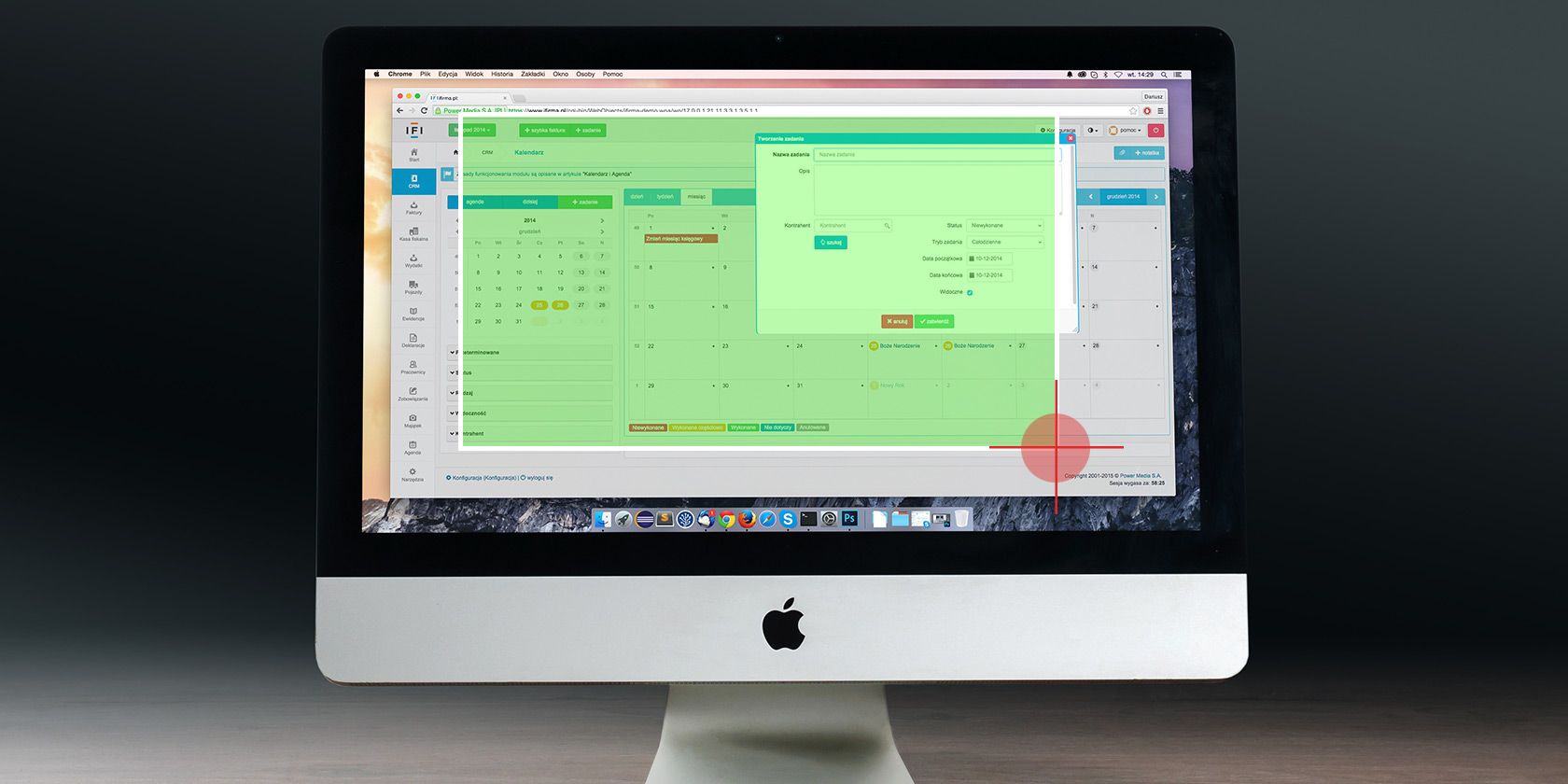
When you want to capture the screen on macOS, you have both native and third-party tools to choose from. Let’s see how to make the best of the screenshot options on your Mac and explore some useful tricks along the way.
macOS has a few default keyboard shortcuts to help you capture the screen instantly. We’ll go through them one by one, as which one to use depends on what exactly you want to take a screenshot of.
(Having trouble with your Mac’s screenshot shortcuts? Ensure that you haven’t disabled them under System Preferences > Keyboard > Shortcuts > Screenshots.)
For this, you need the shortcut Cmd + Shift + 3. It takes a snapshot of the entire screen and saves it to the desktop as a PNG image.
Want to copy the screenshot to the clipboard to paste it elsewhere instead of saving it automatically? Add the Control key to the keyboard shortcut—hit Control + Cmd + Shift + 3. For more on this basic copy-paste procedure, see how to copy and paste on your Mac.
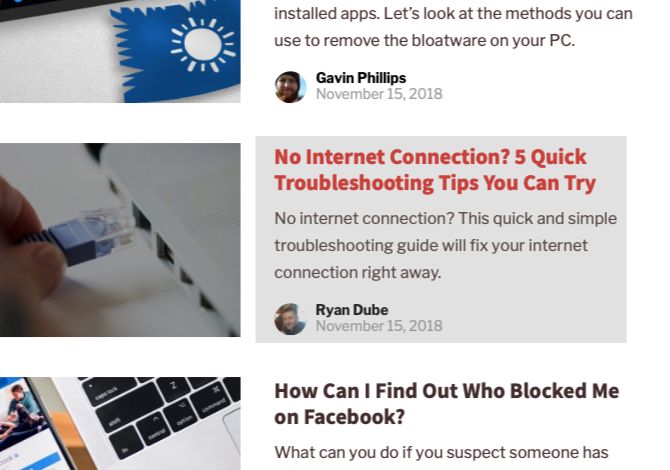
You’ll need to hit Cmd + Shift + 4 if you want to snap a specific portion of the screen. This shortcut turns the cursor into a crosshair; you can then click and drag it across the part of the screen you want to capture.
While making the selection, hold down the Shift key if you want to limit your adjustments to either the X or Y axis. To resize your selection proportionally from the center, hold down the Option key. And if you want to move the selection, hold down Space instead.
(Changed your mind about taking the screenshot? No problem. Hit the Escape key to cancel the action.)
Once you’re satisfied with the selection, release the mouse. The screenshot then ends up on the desktop as a PNG file. As above, if you want to copy the captured image to the clipboard instead of saving it, you’ll need to tweak the shortcut a bit. Modify the shortcut to Control + Cmd + Shift + 4 to copy what you capture.

Want to take a screenshot of the active window? First hit Cmd + Shift + 4. Then hit Space, and you’ll see the crosshair turn into a camera.
The active window appears highlighted, and if you click the camera, you get a screenshot of the window. Before clicking, you can also choose to move the focus of the camera to a different window.
If you want to take a timed screenshot, you’ll need to open your Mac’s built-in screenshot utility. We’ll discuss this in the next section.

Under Applications > Utilities, you’ll find your Mac’s stock screen capture app, aptly named Screenshot. You can also bring up this app with the shortcut Cmd + Shift + 5.
(If your Mac isn’t running Mojave or later, look for the Grab app instead of Screenshot in the Utilities folder.)
With Screenshot, Apple has simplified the whole screen capture process. The app is useful if you prefer a more point-and-click approach over keyboard shortcuts.
Screenshot’s toolbar has three buttons that make screen capture on macOS quick and painless: Capture Entire Screen, Capture Selected Window, and Capture Selected Portion. (The app also has a couple of buttons for screen recording.)
For timed selections, click on the Options button in the toolbar. You’ll find the timer options in the menu that shows up.
After you take a screenshot using any of the options above, you’ll see a tiny thumbnail preview at the bottom-right of the screen. Click on it to reveal a full-fledged preview window with tools to edit, annotate, and delete the screenshot. Here, you can add text, sketches, shapes, and even your signature to a screenshot.
The full-sized preview window also contains an option to open the screenshot with other Mac apps like Notes, Mail, and Reminders.
If you want to turn off the thumbnail feature, uncheck the Show Floating Thumbnail item in the Options menu from the screenshot toolbar.
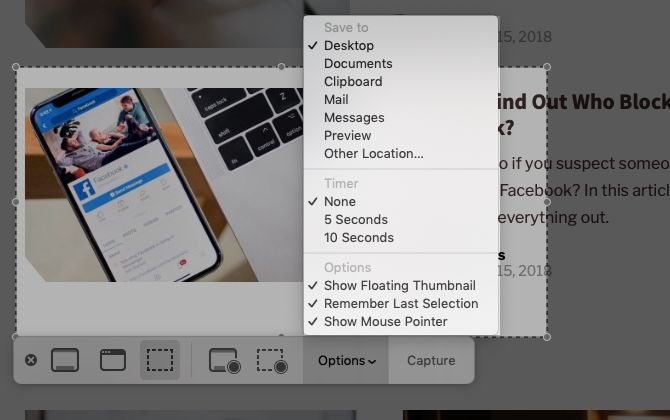
You might want to, say, change the default screenshot format or change where screenshots save to on your Mac. In such cases, you’ll need to execute a command from the Terminal app. Let’s take a look at three of the most useful commands.
We have appended each command with a second one that’s needed to cement the changes. It reads as follows:
killall SystemUIServerYou can save screenshots in other formats like JPG, BMP, and PDF. To do so, you’ll need to replace [file type] in the command below with the relevant three-letter format name:
defaults write com.apple.screencapture type [file type] && killall SystemUIServerOn Mojave and later macOS versions, you can change the default destination folder directly from the Screenshot app. To do this, click on the Options button in the screenshot toolbar and select a folder of your choice under the Save To section of the resulting menu.
On a pre-Mojave Mac, you’ll have to rely on this Terminal command:
defaults write com.apple.screencapture location [path] && killall SystemUIServerReplace [path] with the new Finder save location that reads something like this:
/Users/[Username]/Pictures/ScreenshotsYou can either type the pathname into Terminal, or drag and drop the relevant folder into Terminal to paste its pathname.
Alternatively, you can also copy the pathname and then paste it into Terminal. You’ll find the Copy as Pathname command in the destination folder’s context menu or right-click menu. However, the command appears only when you hold down the Option key while right-clicking.
If you want to replace the default prefix (Screen Shot) in screenshot names with a different keyword, try this command:
defaults write com.apple.screencapture name [file name] && killall SystemUIServerBe sure to replace [file name] in the command with the new keyword before execution.
If you’d rather not fiddle with the Terminal, install a utility that lets you tweak macOS settings without Terminal commands.
The Preview app on your Mac also allows you to take screenshots. It’s just one of the essential macOS Preview tricks you’ll want to know about.
The advantage of using Preview for screenshots is that you can specify a different file format and save location with each new capture. Of course, you can also instantly edit the screenshot in Preview before saving it.
You’ll find the screenshot tools in Preview under File > Take Screenshot. Unfortunately, a timed screenshot option is missing here.
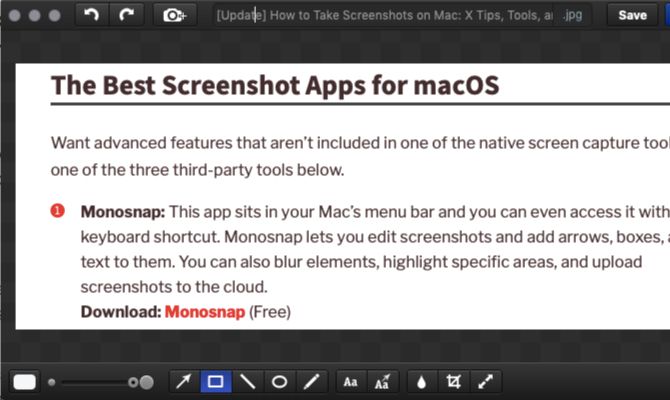
Want advanced features that aren’t included in the in-built screen capture tools on your Mac? Try one of the three third-party tools below.
This app sits in your Mac’s menu bar and you can access it with a keyboard shortcut. Monosnap lets you edit screenshots and add arrows, boxes, and text to them. You can also blur elements, highlight specific areas, and upload screenshots to the cloud. Monosnap made it to our list of the top Mac menu bar apps.
Download: Monosnap (Free)
This app lets you capture various onscreen elements and edit/annotate them without having to open another app. Skitch also supports timed screenshots.
Download: Skitch (Free)
Get Snappy if your work involves collaborating on screenshots or “snaps” often. You can not only edit and annotate screenshots as usual, but also share them with ease. The sharing options include a password-protection feature and a self-destruct timer.
Download: Snappy (Free)
Now you know how to take a screenshot on your MacBook quickly and efficiently. macOS gives you the tools to capture whatever you need.
Why not master the basics of iPhone screenshots next?
Read the full article: How to Take a Screenshot on Your Mac
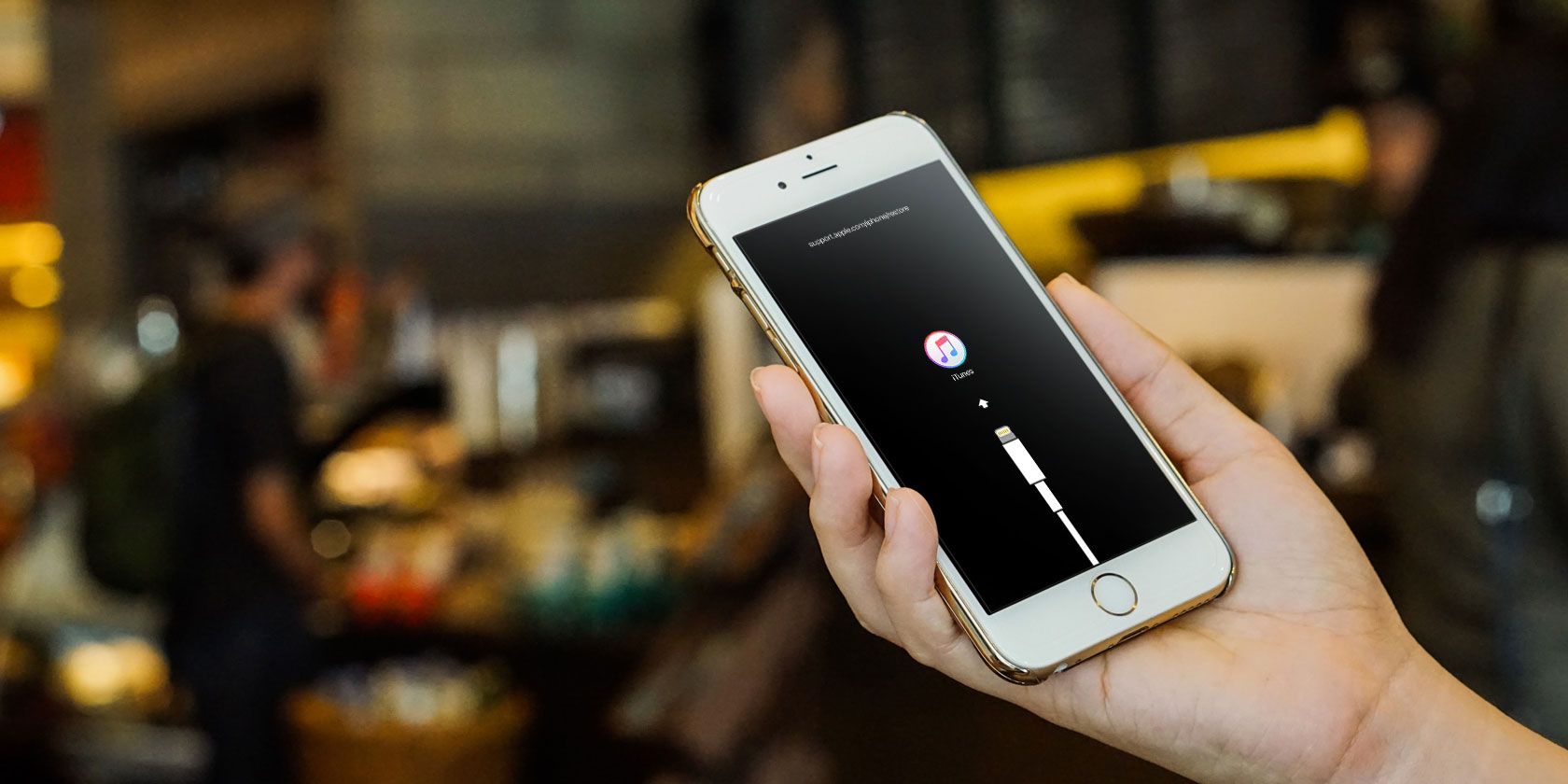
Starting with 2016’s iPhone 7 line, Apple dropped the old mechanical home button in favor of a capacitive touch panel. Since that home button relies on software, it’s no longer used for button inputs like taking a screenshot. Further complicating this, the iPhone X line of devices introduced yet different button combinations.
This means that you might have no idea how to enter iPhone recovery mode on your new device. We’ll show you how to put your iPhone (as well as iPad or iPod touch) in recovery mode, no matter which model you have.
Jump to your device:
You’ll hopefully never need to hard reset your iPhone, but it’s a good tip to know about for those occasions when something goes wrong. For example, this can help you fix ghost touch on your iPhone.
When your device becomes completely unresponsive, you can choose between waiting for the battery to deplete and initiating a hard reset. A hard reset is basically the equivalent of pulling the power plug, forcing your iPhone to shut down and start up again.
Recovery mode takes this a step further, putting your device into a state where you can reinstall iOS by connecting your iPhone to a computer running iTunes (or by using Finder on macOS Catalina and newer). If your iPhone refuses to boot or crashes on startup, you’ll need to put the device into recovery mode in order to rescue it.
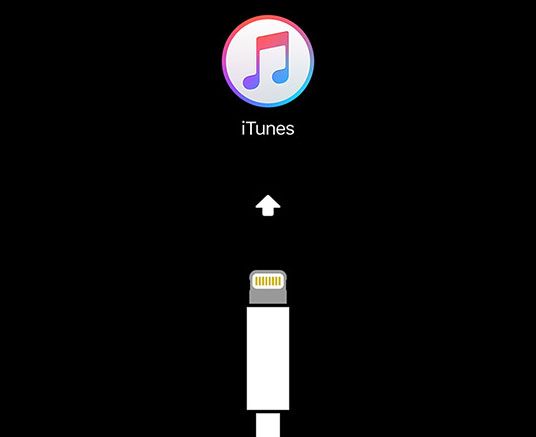
Note that when you reinstall iOS, you’ll lose all the data on your iPhone. This isn’t a problem if you make regular iPhone backups, which you can do using iCloud or locally in iTunes or Finder. Unfortunately, you can’t back up your device in recovery mode, since iTunes will only offer to restore the firmware.
As such, if you are stuck with an iPhone that won’t boot and you don’t have a backup to restore, there’s nothing you can do to save your data.

Apple changed the button combination to force restart on the iPhone 8 and later. The below steps will work with the iPhone 8/8 Plus, iPhone X, XS, and XR, and iPhone 11 line.
Note that you’ll need to perform these button combinations fairly quickly.

Both the iPhone 7 and larger iPhone 7 Plus model were released in September 2016. These were to first iPhones to lack a mechanical home button, which required Apple to change these shortcuts for the first time since the iPhone launched in 2007.
You’ll also need to follow these steps to force restart the 7th generation iPod touch, released in 2019.

The iPhone 6s, released in 2015, was Apple’s last iPhone with a mechanical home button. The following advice is good for that device, as well as all iPhones that came before it. This includes the Plus models, iPhone SE, and iPod touch 6th generation and earlier.

Need to force restart or use recovery mode on your iPad instead? The process is simple.
To do this on an iPad model with a Home button, follow the same instructions for force restarting the iPhone 6s and earlier described above. If you have an iPad with Face ID, follow the above steps to force restart an iPhone 8 or newer.
Just note that on iPad, the power button is on top, not on the side.
When you put your device into recovery mode, you’ll have 15 minutes to begin reinstalling iOS before your device automatically exits Recovery Mode. You’ll need to repeat the combination of button presses in order to put it back into Recovery Mode if this happens.
Your device will not show up as normal in iTunes or Finder while in Recovery Mode, and you’ll see an error message like the one above. You can always choose to update the firmware, or simply restore the existing version.

Once your iPhone reboots as normal, you will need to log in with your credentials to remove Apple’s Activation Lock. This is a security feature that prevents someone from using your device if you reset it without signing out of iCloud.
Because of this, you should never buy an iPhone if the seller refuses to unlock it in front of you. A reset phone with Activation Lock still enabled will ask for the owner’s Apple ID before you can begin the setup process.
We’ve seen how to force restart your device and enter recovery mode, no matter what iPhone, iPad, or iPod touch model you have. It’s a simple process once you know it, but the increasingly confusing button combinations are a bit obtuse.
For more on recovery, check out what to do if you forget your iPhone passcode.
Read the full article: How to Force Restart an iPhone and Enter Recovery Mode
![]() Hello, my name is Srikanth. I'm interested in learning new things and sharing with everyone.
Hello, my name is Srikanth. I'm interested in learning new things and sharing with everyone.
Learn More →